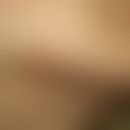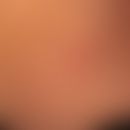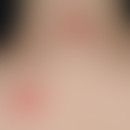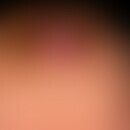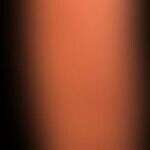Synonym(s)
HistoryThis section has been translated automatically.
Balzer and Mercier 1898; Senear and Caro 1941
DefinitionThis section has been translated automatically.
Acquired, striped, inflammatory dermatosis following the Blaschko lines (lichen planus as cutaneous mosaic dermatosis) of unknown etiology (see comments on Blaschko-linear inflammatory dermatoses).
You might also be interested in
EtiopathogenesisThis section has been translated automatically.
The genesis of lichen striatus is still a matter of debate. Obviously, only single keratinocyte clones become diseased. Frequently, the first manifestation occurs after a viral infection.
Intrafamilial clustering has also been reported.
Currently, it is assumed that a new antigen is expressed on the keratinocytes of a clone in the course of the infection, which then leads to a local inflammatory reaction.
ManifestationThis section has been translated automatically.
Occurs mainly in children and young people.
LocalizationThis section has been translated automatically.
Asymmetrical: mainly arms, legs (less often: neck or trunk).
ClinicThis section has been translated automatically.
Small reddish, usually less symptomatic, lichenoid, psoriasiform or eczematous flat papules confluent to a reddish, 0.5 - 2.0 cm wide, possibly extending over the entire length of the limb (see also ILVEN). After regression (experience shows that skin changes persist for years), long-term post-inflammatory hypo- and hyperpigmentation may be detectable. Sometimes several stripes are affected in the sense of a systematization. If the stripes end at fingers or toes, nail dystrophy may also be present.
HistologyThis section has been translated automatically.
The hsitological picture is non-specific. Evidence includes images of interface dermatitis with epidermal hyperplasia, circumscribed parakeratosis, single dyskeratotic cells scattered throughout the epithelial band. Mild perivascular lymphocytic infiltrate with minor exocytosis as well as mild spongiosis.
Differential diagnosisThis section has been translated automatically.
ILVEN: ILVEN is not seen as a differential diagnosis, since lichen striatus is considered by many to be a variant of ILVEN, or both clinical pictures are to be subsumed under the designation"Blaschko-linear inflammatory dermatoses".
Note: The term "Blaschkitis" (Grosshans) is probably synonymous with lichens striatus in adults.
Nevus verrucosus unius lateralis: The inflammatory component is absent in this clinical picture, which is also aligned in the Blaschko lines.
Lichen planus linearis (histologic workup).
Linear psoriasis (histological clarification).
TherapyThis section has been translated automatically.
Progression/forecastThis section has been translated automatically.
Formation in 2 to 4 weeks, regression in a period of about 3 months, possibly up to a year, but persistence for years is also possible. Recurrences after healing can occur (as with ILVEN) (see also comments on Blaschko-linear inflammatory dermatoses).
LiteratureThis section has been translated automatically.
- Fujimoto N et al (2003) Facial lichen striatus: successful treatment with tacrolimus ointment. Br J Dermatol 148: 587-590
- Gokdemir G et al (2003) Lichen striatus associated with chronic plaque psoriasis in an adult. J Eur Acad Dermatol Venereol 17: 617-619
- Hofer T (2003) Lichen striatus in adults or 'adult blaschkitis'? There is no need for a new naming. Dermatology 207: 89-92
- Kavak A, Kutluay L (2002) Nail involvement in lichen striatus. Pediatric Dermatol 19: 136-138
- Luther H et al (1990) Naevoid psoriasis, psoriasiform ILVEN or unusual lichen striatus? Nude Dermatol 16: 306-309
- Reiter H et al (2000) Lichen striatus or blaschkitis in the adults. Variations of the same entity? Dermatologist 51: 770-773
- Senear RD, Caro MR (1941) Lichen striatus. Arch Dermatol Syph 33:116-133
- Zhang Y et al (2001) Lichen striatus. Histological, immunohistochemical, and ultrastructural study of 37 cases. J Cutan Pathol 28: 65-71
Incoming links (9)
Apoptosis; Blaschkitis; Blaschko-linear inflammatory dermatoses; Ilven; Interface dermatitis; Lichen aureus; Linear dermatitis; Segmental Vitiligo; Spongiosis;Outgoing links (8)
Blaschko-linear inflammatory dermatoses; Blaschko lines; Ilven; Interface dermatitis; Lateral nevus verrucosus unius lateralis; Lichen planus linearis; Papel; Spongiosis;Disclaimer
Please ask your physician for a reliable diagnosis. This website is only meant as a reference.
